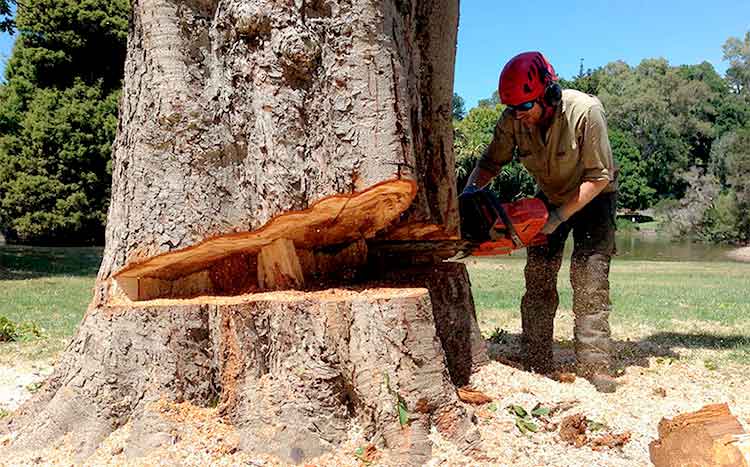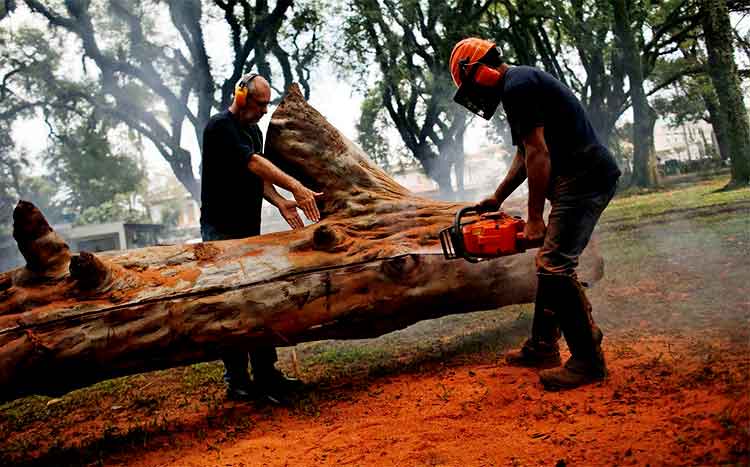Many state and council authorities consider trees essential to their environment and natural heritage. And laws are enacted to protect them against wanton destruction. Illegal tree-cutting penalties can be devastating to your finances. Read on to learn more about how to avoid them.
The penalty for cutting a tree without a permit range from $2,000 to $120,000, depending on the state you reside. The maximum penalty is by the Land and Environmental Court of New South Wales, which can impose fines of up to $1.1 million for cutting down a protected tree on your property.
Tree owners unsure about the tree laws in their area should consult their local council planning authorities or discuss with a qualified arborist for more information.

Table of contents
ToggleAverage fines for cutting a tree without a permit
Table showing average fines for remixing a tree without permits across Australia.
| Low | $500 - $2,000 |
|---|---|
| Average | $5,000 - $15,000 |
| High | $25,000- $100,000 |
Many Australian states have clearly defined penalties for cutting a tree without a permit. Average fines for unlawful tree removal across Australia range from a low of $500 for on-the-spot penalties to over $100,000 for cutting down protected trees.
Fines for cutting down a tree without a permit per state
New South Wales: local councils in New South Wales use Local Environment Plans (LEPs) and Tree Preservation Orders (TPOs) as guides to determine fines for cutting or pruning a tree without a permit. Courts can impose a maximum fine of $110,000 for violating a TPO, while offenders in the Land and Environmental Court of NSW can face penalties of up to $1.1 million.
Queensland: fines across Queensland vary as each local council has its tree protection laws stipulating different penalties for tree offenses, including cutting trees without a permit.
South Australia: the Planning and Design Code under the South Australia Planning, Development and Infrastructure Act 2016 makes it mandatory for tree owners to obtain a permit before cutting a ‘regulated’ or ‘significant’ tree. Fines for breaching the law range from $60,000 to $120,000.
Western Australia: local councils handle tree protection laws across Western Australia, which prevent cutting down trees in the following categories without a permit.
- Trees with outstanding visual and aesthetic significance.
- Trees with outstanding botanic and scientific significance.
- Trees with significant ecological value.
- Trees with significant cultural, social, or commemorative value.
Fines for cutting down these trees consist of a general penalty of $200,000 and $25,000 for each day of a continuous offense, including an infringement notice of $500.
Tasmania: the Land Use Planning and Approvals Act, 1993, is enforced in Tasmania by local councils. Fines for violation of the law, including cutting down protected trees without a permit, can get as high as $10,000.
Victoria: penalties for cutting trees without a permit in the state of Victoria are minimal. For example, the city of Boroondara imposes a maximum fine of $2,000 fine per offense.
Canberra: has the most extensive and well-defined tree protection regulations. The Tree Protection Act of 2005 prohibits cutting down the following trees:
- Trees that are 12 meters tall.
- Trees with a trunk circumference measuring 1.5 meters.
- Trees with a canopy measuring more than 12 meters
The Northern Territory: does not have specific regulations protecting trees growing on private property. Except laws concerning heritage trees as specified by the Heritage Conservation Act
What to do before cutting down a tree
Tree cutting involves a lot more work than just picking an ax and chopping away. There are tree regulations that prevent wanton removal or damage of trees on private property. And the penalties for violating these laws range from mild to severe, depending on where you live. So this means that you may not have the right to cut down a tree, even if it belongs to you.
Below is a list of steps to follow if you want to cut down a tree on your property.
Have an arborist assess the tree
It is vital to have a tree expert examine the tree before starting the application for removal. Tree owners can unintentionally exaggerate or misdiagnose a tree’s condition as grounds for removal, which authorities may reverse upon examination. Local officials are more likely to issue permits to remove trees under the following conditions:
- A dead tree.
- A dying or sick tree.
- Trees with a severe bug infestation.
- Trees growing close to power lines or with roots that are intruding on home foundations and the sidewalk.
- A bent or dangerously leaning tree.
- Trees that shed excess leaves or debris can cause fire hazards during hot, dry months.
Determine if the tree is within your property
Australian tree laws do not permit you to cut down trees growing on your neighbor’s property. Many states have regulations concerning neighbor disputes about trees, including when someone cuts down a tree on a property that is not theirs. It is important to note that councils do not issue permits to cut down your neighbor’s tree.
Find out your council rules for tree removal
Tree removal regulations across Australian councils are based on methods that include:
- Prescribed lists.
- Heritage or aboriginal value.
- Aesthetic value.
- Tree height.
- Tree diameter.
Roughly half of the Australian councils have a heritage tree list or significant register. You generally require development consent to cut a tree included in such a list or register. In contrast, you must obtain a permit before removing a tree under the protection of a development control plan. Most councils do not require a permit to remove a dead tree or a tree considered an “obnoxious weed,” such as palms. We recommend checking your council rules for tree removal to determine if you need a permit to remove a tree on your property and the permit type you need.
Apply for a permit
You can apply for council permission in person or online to remove a tree on your property. Permits for tree removal applications vary. Cities such as Sydney charge $85 for a permit and $100 for a development consent application, including an extra $535 notification fee. A successful application must include a valid reason and supporting documentation which consists of the following:
- A tree risk assessment report.
- A report indicating possible damage to a building or other structure.
- Copy of building permit.
- The tree’s medical certificate report indicating the medical condition of the tree.
- Other documents.
Hire an arborist to remove the tree
Hiring an arborist can be tricky if you reside in a state where an arborist doesn’t require a license to practice. However, a skilled and experienced arborist should possess the following documents:
- A worker’s compensation insurance or liability insurance for damage to a client’s property.
- A Certificate II in horticulture for ground and climbing work.
- A Certificate III in horticulture for supervising work.
Apart from providing the above documents, arborists should also be able to furnish references for their work. Costs for tree removal vary. The table below illustrates the average prices charged by arborists.
| Tree Size | Price Range |
|---|---|
| Small | $550 - $800 |
| Medium | $1000 - $1500 |
| Large | $2500 - $4000 |
| Massive | Above $5000 |
When do I need a permit to cut a tree?
Generally, councils are in charge of issuing tree-cutting permits. And they decide their local rules on tree management and removal. Council officials typically evaluate an application for tree removal based on the potential harm (if any) caused to the tree and the environment. However, council authorities may grant a permit for tree removal in situations where there is evidence of the tree causing property damage. And the damage can not be fixed without impacting the tree’s health.
Below are the tree removal requirements across Australia’s different councils.
- Tree diameter – you generally require a permit to remove trees with a circumference larger than 1.3 feet. Councils may not require a permit to remove trees smaller than 1.3 feet in diameter. However, the range often varies per council. Queensland’s Doomadgee and Cherbourg councils need a permit to cut down trees with a diameter of 1.6 feet.
- Tree species – most councils will require a permit to cut down native tree species due to their cultural or environmental significance. For example, Vegetation Protection Orders for the Barcoo Shire Council in Queensland prevent people from cutting certain tree species without a permit.
- Tree height – tree protection laws in many councils, prevent the cutting of trees taller than 3 meters without obtaining a permit. Local councils in New South Wales require a permit to cut down trees above 3 meters in height or with a crown taller than 2 meters.
What trees can I cut without a permit?
There are certain tree species that you can remove without a permit. Tree protection laws across Australia declare non-native and invasive pest species exempt from protection. Also, certain species of trees like the plant are classified as obnoxious weeds, which are fair game for removal. Residents of Hornsby in New South Wales can legally remove the following trees from their property without a permit.
- Dead trees.
- Non-native trees.
- Trees considered by a certified arborist as an imminent risk to life or property.
- Trees listed under the 2015 NSW Biosecurity Act.
- Trees less than 3 meters tall and not located within the vicinity of any native vegetation.
- Trees growing less than 3 meters away from an existing dwelling or pool.
- Exempt tree species as prescribed in Table 1B.6(a) of the Hornsby DCP.
You can remove trees growing within 20 meters of a building in Adelaide Hills or other locations with moderate to high bushfire risk.
How hiring an arborist can help you avoid tree cutting penalties
Hiring a tree expert (arborist) to remove a tree from your property can literally save you thousands of dollars in avoidable fines. They can assist you with getting a council tree removal permission because a large part of an arborist’s job is to remove dead or unhealthy trees. And they are familiar with the permit process more than you do. Here are some of the ways they can help you:
- Certified arborists can provide an assessment of the tree’s condition status to the authorities.
- They can help document evidence, including photos of the tree indicating if it poses a hazard to lives and property.
- They help with writing properly worded documents correctly, highlighting why you require a permit to have a tree removed.
- Their considerable experience in handling permit applications helps in dealing with ornery council officials.
FAQ's
Most councils do not require a permit to cut down a tree less than 1.5 feet in diameter or less than 3 meters tall. But you need to check your local council laws to be sure of the tree regulations for your area.
- Coral Tree
- Chinese Nettle Tree
- Liquidambar
- American Nettle Tree
- Camphor Laurel













